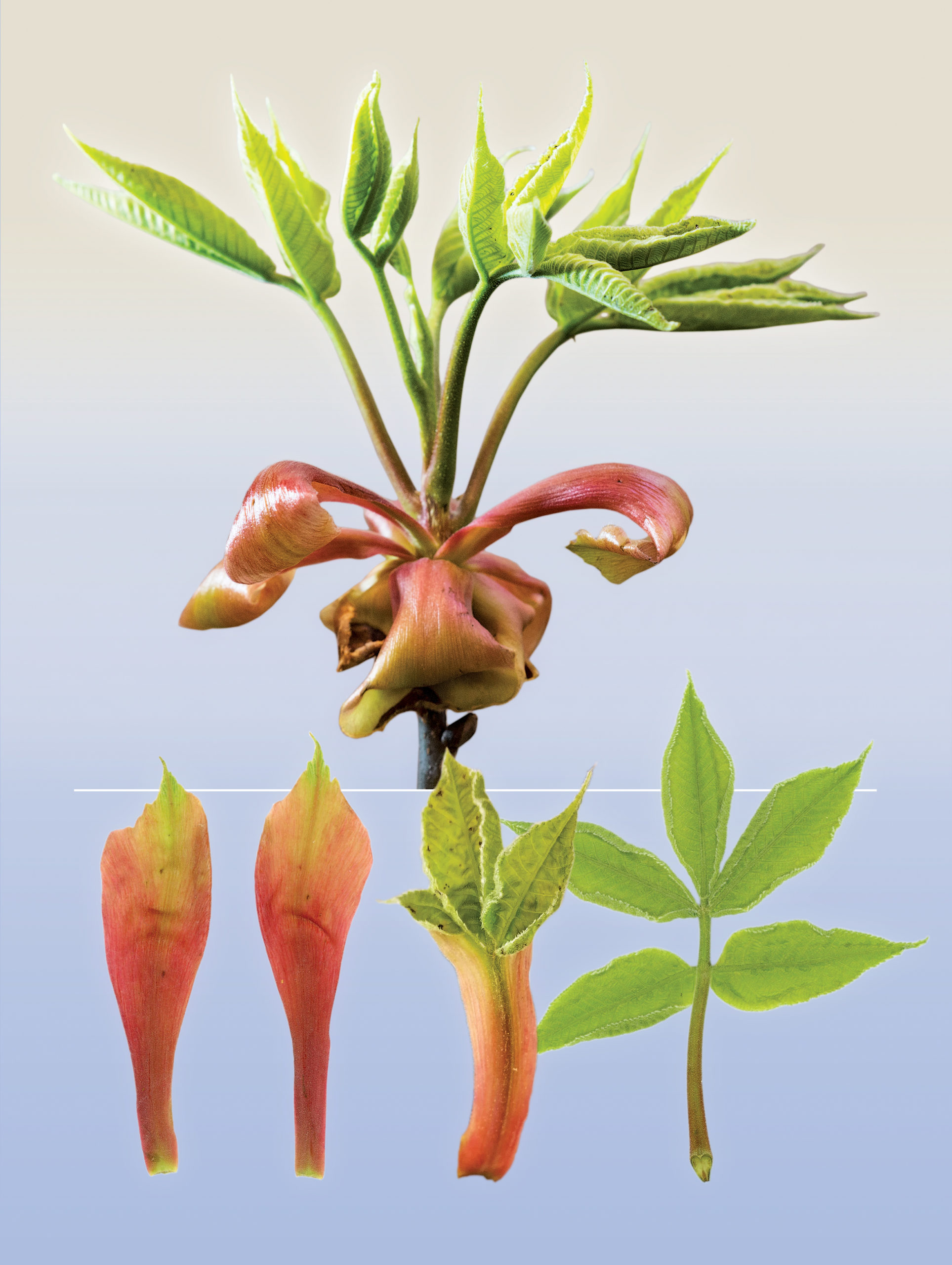When we welcome new foliage in the spring, we must also bid adieu to another set of structures that have adorned trees throughout the winter: the bud scales. That’s right, May is the perfect time for bud-scale peeping, and there is no finer tree to start with than the shagbark hickory (Carya ovata), a Massachusetts native. With its fingerlike leaflets pointing towards the sky, emerging from a skirt of magenta scales, the spring shoot of a shagbark hickory is reminiscent of an alien that has recently taken up flamenco dancing. A large grove of shagbark hickories (accession 12907) can be observed near the Centre Street entrance to the Arnold Arboretum, and for an observant spring enthusiast, the spectacular display is likely to turn an easily overlooked piece of botany into a pressing question: What are these pink structures?

Buds scales are best known for their winter protective role. Trees repeatedly develop new organs (leaves) throughout their lifetimes, but this mode of continuous development can be challenging in a temperate climate. In the words of John Muir: “Consider what centuries of storms have fallen upon [trees] since they were first planted,—hail to break the tender seedlings; lightning, to scorch and shatter; snow, winds, and avalanches, to crush and overwhelm,—while the manifest result of all this wild storm-culture is the glorious perfection we behold.” Bud scales are one item in a long list of adaptations that make this glorious perfection possible, and not an insignificant one. Bud scales envelop the sites where new leaves are initiated. Newly formed miniature leaves, waiting for spring, are thus provided with a sheltered space for their earliest development.
As the leaves mature within the bud scales, their familiar form, comprising a leaf blade, a leaf stalk, and a leaf base (the attachment point of the leaf to the stem), begins to appear. To understand what bud scales truly are, in addition to what they do, we have to follow this closely coordinated chain of leaf development even further back to when the scales themselves were first formed. Bud scales are, in fact, leaves—modified leaves, never meant to capture light over the growing season. When a tree builds a bud scale, it makes a leaf with just a long and thin version of a leaf base and none of the other components. We know this because vein patterns in the base of certain photosynthetic leaves are similar to those in bud scales. In addition, if you look at a lot of bud scales, and you are lucky, then you might find a happy accident where a leaf has ended up half bud scale and half foliage leaf, indicating the relatedness between the two forms. Moreover, we know that bud scales and photosynthetic leaves are initiated in the same pattern, from the same cell clusters.
New bud scales appear relatively early in the season for shagbark hickories. In fact, if you examine the tender stems that emerge with the fresh leaves in the spring, you can already see the very earliest, minute instances of the new bud scales—including the pink flamenco dresses of the following year. This way, the growing tips are not only protected during winter but are never once exposed through the four seasons.
Citation: Schoonderwoerd, K. M. 2020. Spring is the New Fall. Arnoldia, 77(4): 44–45.
It follows that the conspicuous pink phase in early May is but the swan song of the shagbark hickory’s bud scales. After many months of passive sheltering, the scales start to rapidly expand and change color in the spring. The reddish color may well point towards a continued protective role. These blushes are caused by anthocyanins, the very same compounds that color leaves red or purple in the fall. The currently most-favored hypothesis states that anthocyanins function as a sunscreen, protecting delicate structures—new, growing leaves in this case—from excess sunlight. Perhaps the spring metamorphosis observed in the shagbark bud scales is a final act to guard the small but rapidly expanding leaves, until the leaves can grow and function without outside protection and the scales can drop away, no longer needed, and make way for the next cohort.
Kristel Schoonderwoerd is a doctoral candidate in the Friedman Lab at the Arnold Arboretum.
From “free” to “friend”…
Established in 1911 as the Bulletin of Popular Information, Arnoldia has long been a definitive forum for conversations about temperate woody plants and their landscapes. In 2022, we rolled out a new vision for the magazine as a vigorous forum for tales of plant exploration, behind-the-scenes glimpses of botanical research, and deep dives into the history of gardens, landscapes, and science. The new Arnoldia includes poetry, visual art, and literary essays, following the human imagination wherever it entangles with trees.
It takes resources to gather and nurture these new voices, and we depend on the support of our member-subscribers to make it possible. But membership means more: by becoming a member of the Arnold Arboretum, you help to keep our collection vibrant and our research and educational mission active. Through the pages of Arnoldia, you can take part in the life of this free-to-all landscape whether you live next door or an ocean away.
